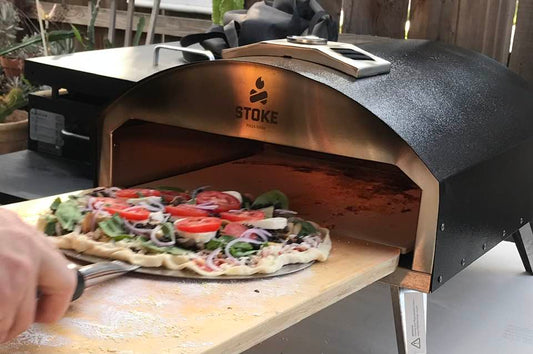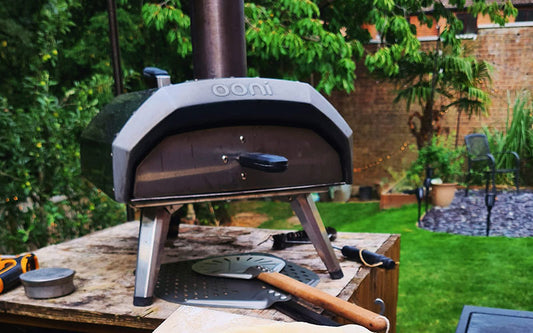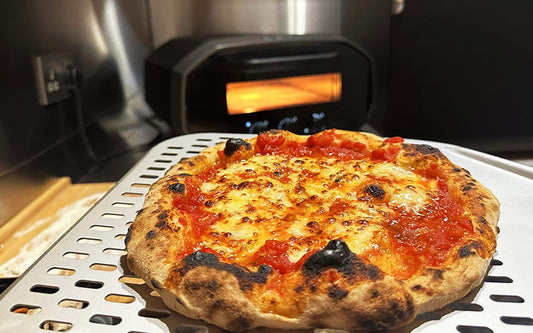According from U.S. Census data and Simmons National Consumer Survey (NHCS), in 2020, over 203 million U.S. citizens consumed frozen, store-bought pizzas.
With pizza being a staple in almost every American household, the demand for home pizza-making solutions is evident.
However, not everyone has the time or space for a large outdoor pizza oven. This is where indoor pizza ovens come in.
These compact, electric-powered appliances are easy to use and perfect for crafting Neapolitan-style pizzas at home, whether you’re starting from scratch or using store-bought pie.
If you’re in search of an indoor pizza oven, you’ve come to the right place.
🥇Best Portable Indoor Pizza Oven
- Ooni Volt 12 Electric Pizza Oven (Best Overall)
- Breville Smart Oven Pizzaiolo Pizza Oven (Best for High-Ends Ovens)
- WISCO INDUSTRIES, INC. 421 Pizza Oven (Best for Versatility)
- Presto Pizzazz Plus Rotating Countertop Oven (Best for Budget)
How I Tested?
Navigating through numerous models on the market, I carefully selected the top 20 electric pizza ovens, considering brand reputation, customer reviews, and improved design.
These chosen ovens underwent a standardized test, each baking three classic cheese pizzas consecutively. The objective was to identify models showcasing impressive cooking consistency, maintaining constant factors like dough moisture, amount of mozzarella cheese, and tomato sauce.
Following the manufacturer’s instructions for preheat time, cook time, and cooking presets, each pizza oven was scored based on the cooking result – crust flavor, crispness, and color – ease of use, smoke incident, and cleanup process.
🔍Factors to Consider when Choosing an Indoor Pizza Oven
After testing more than a dozen indoor pizza ovens, I’ve identified crucial factors that every homeowner should consider before investing in one.
Size and Capacity
Most electric pizza ovens like the Volt 12 and Breville Smart Oven Pizzaiolo are similar to regular kitchen ovens in size. If you can’t afford to sacrifice another space for a cumbersome appliance, go for smaller and more compact pizza ovens like Presto Pizzazz.
When it comes to size, you also want to think of capacity. Large pizza oven might take up a lot of space on your counter, but they are capable of making more than personal pies. If you want a nifty kitchen gadget that makes up to 12-inch pizza, consider models with 13-inch cooking space. You’ll need that extra space for spinning pizza without feeling cramped.
Baking surface
The type of baking surface an indoor pizza oven uses affects your pie’s taste. However, these baking surfaces have their advantages and disadvantages.
Steel surfaces usually feature a non-stick coating for easy food release and cleaning. They are very durable and can withstand being mistakenly dropped. However, they won’t deliver that authentic Italian pizza taste. For reheating frozen pies, I suggest pizza ovens with a nonstick pan – easier to use and clean.
If you want a stone-baked taste and flavor, consider appliance with a baking stone. Its porous surface lets it wick away moisture for a perfectly crispy crust in a few seconds. Sadly, it’s not as durable as its steel counterpart. Plus, cleaning them is more challenging than the non-stick baking steel.
Temperature Range
This is perhaps the most important factor when shopping for a pizza oven. These appliances have different minimum and maximum temperatures. I notice that it determines exactly what you can cook in them. Also, their temperature range can affect your pizza texture and taste.
Look for high temperatures between 750 – 800 degrees F, it’s necessary for baking a Neapolitan pizza. It help achieve base charred and cooked through in less than 2 minutes. Therefore, it’s crucial that you pick models that come to temperature quickly.
If you are baking everything else except a Neapolitan-style pizza, then models with 212 – 700 degrees F temperature range might be your best bet.
Heating controls
The latest indoor pizza ovens feature two heating elements. This allows you to sear the pizza base while broiling the top ingredients.
Therefore, it’s important that the oven allows you to control the temperature of each element independently. This way, you can cook the base faster and vice versa. This way, you can avoid soggy pizza bases or burnt toppings, a typical problem with outdoor models.
Safety Features
For homeowners with kids and pets, it’s crucial to consider the oven’s safety features. The right oven should come with a locking door or cool touch handles. Some units like Ooni Volt 12 feature a powered coating exterior to ensure it’s safe to touch.
Also, you want the oven equipped with a built-in timer. It really comes in handy. It prevents your pizza from burning. Also, it helps extend the device’s lifespan while ensuring huge energy bills.
⭐Best Indoor Pizza Oven Review
1. Ooni Volt 12 Electric Pizza Oven
The Ooni brand, renowned among backyard pizza enthusiasts, has introduced the Volt 12, an electric model that matches the excellence of its gas and wood-fired counterparts.
Boasting a plug-and-play setup, this oven stands at 24.2 x 20.8 x 10.9 inches, occupying substantial countertop space. It’s not a great choice for pizza lovers with small kitchens.
Plus, it weighs about 40 pounds, you’ll need a lot of muscle to move this device around. It’s best left on the countertop, but it’s not as good looking as the Breville Smart Oven Pizzaiolo.
This unit utilizes two heating elements that heats up an included thick stone up to 850°F in 22 minutes. While this unit has a low clearance, it’s spacious enough to bake a 12-inch Neapolitan-style pizza to crisp results. It’s not perfect for baking bread or tall pastries since there’s no room to rise.
In testing, the Volt 12 required some learning curve. The first two test pizzas got burnt, producing lots of smoke.
Finally, I figured it out – preheat the stone to 850°F, redirect the heat to the top element using the “Balance” dial and turn if required. Also, toppings spilling inside the oven create smoke that can be unsettling but doesn’t ruin the taste of the pizza.
Subsequent neapolitan-style pizza I tried baking turned out great with nice char marks on the crust and chewy on the inside. On average, this oven cooks a picture-worthy pizza in 1 minute 15 seconds. While it does not require much turning like the Koda 16 and the likes, it’s important to keep an eye on it via the door’s window.
Aside from its tendency to create smoke, the stone temperature drops when exposed by 60 – 80°F. For best results, limit how often you open the lid to preserve the heat.
The Ooni Volt 12 consumes 0.47 kWh per use, translating to an approximate cost of 8 cents, based on February 2024’s average electricity rates.
What I Like:
- Best-in-class build quality
- Impressive heat up
- Perfect for indoor and outdoor use
My Dislikes:
- Expensive
- Cumbersome and heavy
2. Breville Smart Oven Pizzaiolo Pizza Oven
The Breville Smart Oven Pizzaiolo shares a similar design to other appliances like air fryers from the brand. I prefer the shiny stainless steel construction to the powdered-coating on the Volt 12. It’s eye-catching and worthy of living rent-free on a kitchen counter, but that’s just preference.
Though not as wide and deep as the Volt 12, the Pizzaiolo will eat up a lot of space on your counter. It features extras absent in the Volt 12, such as a stainless steel peel and carbon-steel pan valued at around $80.
Despite its higher 1800W heating element, this oven reaches a maximum temperature of 750°F in about 16 minutes, on par with the Volt 12. After turning off, it efficiently employs a cooling fan, taking 13 minutes to lower the temperature and protect delicate components.
The Pizzaiolo boasts a number of handy presets like Pan, New York, Frozen, and Wood-Fired pizza.
For this test, I used the “Wood-Fired” option, which automatically adjusts the heat level for the optimal condition. It produced pizzas with characteristic leopard spots, puffy edges, and evenly melted cheese – no wood-fired flavor. However, I had to wait for the oven to recover before launching the next pizza for best results.
On the downside, you’ll have to deal with smoke when excess flour makes it to the oven. It’s not a deal breaker as the smoke goes out just as quickly. Plus, cleaning the mess is a challenge with the baking deck attached to the lid. When brushing the debris, you’ve to be careful not to allow it to fall through the cooking deck into the heating element below.
What I Like:
- Loads of preset functions for novice
- Attractive stainless steel design
- Includes a peel-and-pan
My Dislikes:
- Pricey
- Tedious cleanup
3. WISCO INDUSTRIES, INC. 421 Pizza Oven
Straight out of the package, what caught my attention was its compact design and feather-light weight of approximately 19lbs. Its versatility shines, fitting into tight spaces and being effortlessly portable—an ideal pick for those with space constraints.
Powered by a 1500W Long Life Calrod heating element, the Wisco 421 packs a punch, reaching temperatures up to 500℉. It seamlessly transitions from a conventional oven with racks to a pizza oven with the introduction of a cordierite stone.
The roomy rack accommodates a 12-inch pizza stone or perforated pan. Opting for the stone takes a bit longer, around 10 minutes, but rewards with a crisp, beautifully colored pizza crust in just 6 minutes and 23 seconds. The perforated pan delivers equally delightful results without the distinctive stone-baked flavor.
For a quick fix with frozen pizzas, this oven comes with a “Quick one-touch setting”, capable of producing a mouthwatering pizza in a mere 10 minutes.
While it’s not up to par with the Volt 12 and Pizzaiolo, this unit bakes amazing pies with patience. If you want to, this oven is perfect for cooking quesadilla, roasting stuffed pepper, and reheating any dishes.
One quibble with the Wisco 421 is its knob function. It’s tricky to control the temperature and cook time without accidentally turning it off. With practice, it becomes more manageable. Additionally, the handle appears somewhat flimsy, lacking the sturdiness found in other models I’ve tested.
What I Like:
- Digital display
- Works as a pizza and conventional oven
- Compact and lightweight
- Easier to clean
My Dislikes:
- Control knob is tricky to use
- Slower cook time
4. Presto Pizzazz Plus Rotating Countertop Oven
The Presto Pizzazz Plus employs two heating elements like the others but comes with a rotatory nonstick pan instead of a stone. While this simplifies cleanup, it comes at the cost of the distinctive taste associated with stone-baked pizzas.
The rotatory pan offers enough space to make a 12-inch neapolitan-style pizza. It doesn’t require preheating, but I couldn’t get the crust brown enough within the advertised 12-minute bake time. For each test pizzas, I had to cook the crust for an extra 6 – 10 minutes while turning off the top heating element for some color on the crust.
While excelling with frozen pies, the Presto Pizzazz Plus faces challenges with freshly made dough. The dimpled pan tends to trap moisture under the dough, resulting in soggy pizzas.
Another problem might be the low heat capacity of the bottom heating element. It’s only capable of heating the nonstick pan up to 350°F, which is not ideal for crafting authentic neapolitan pizza.
In all honesty, this unit may not excel at creating traditional Italian-style pizza and may not be the top choice for those keen on making pizza from scratch. However, it earns a recommendation for busy pizza enthusiasts seeking a quick solution to reheat frozen pizzas.
What I Like:
- Portable
- Affordable price point
- Easy to use and clean
My Dislikes:
- Not ideal for fresh pizza
⚖️Difference Between Convectional Oven and Indoor Pizza Oven
Understanding the differences between a kitchen oven and an indoor pizza oven is crucial to making iconic pizzas at home. There are different types of pizza ovens – electric, gas, and wood fire.
What differentiates the pizza oven from the regular oven is temperature attainable. Pizza ovens are designed to reach up to 900 degrees Fahrenheit. Regular ovens are limited to 500 degrees Fahrenheit. Temperature is crucial to making great pizzas. The right oven should be able to hit around 750 degrees F for perfectly crispy pizza in 60 – 90 seconds.
On top of that,
Pizza oven delivers superior pizza texture. The exterior is golden brown with a charred base while remaining moist inside. This is something nearly impossible to achieve with standard ovens. This kitchen appliance tends to dry out the crust.
With an indoor pizza oven, you get better caramelization and beautiful “leopard” than the standard oven.
No doubt, standard ovens are versatile. However, it’s unsuitable for making great pizzas like pizza ovens.
🤔Benefits of Owning an Indoor Pizza Oven
It’s okay to wonder why most pizza enthusiasts are suddenly raving about these models. This appliance is touted to be a must-have for baking memorable pizzas. Are they worthy? Should you purchase one immediately? Here are the most compelling reasons to purchase an indoor pizza oven
Easy to Maintain and Use
Unlike wood-fired models, indoor pizza ovens are a breeze to use. They are made from top-quality aluminum and steel. This makes them highly resistant to corrosion, despite being an indoor model. They are durable enough to withstand the rigors of everyday use.
Also, they are easier to clean after every use. They are mostly electrical, meaning no flame. Thus, you don’t have to spend most of your free time cleaning out ash or smoke residue.
Some models come with a non-stick baking surface for minimal cleaning requirements. However, I prefer baking stone for its crisp performance. Besides, cleaning it only requires using a brush to scrub off burnt-on.
Quick Cook Times
A portable indoor pizza oven usually comes with a 12-inch cooking surface. Their small size means some area to heat up. They come to temperature faster than other large-sized or outdoor models. Thus, their quick cooking time makes them perfect for making amazing homemade pizzas almost instantly.
Thanks to their superior engineering, these models have their heating element close to the cooking surface. This way, it heats up faster and holds the temperature better than outdoor models. The upside is it allows you to cook several pizzas without a long wait in between.
Extra Features
Most indoor pizza ovens come with a host of additional features to improve your baking experience. These small and compact appliances are equipped with built-in thermometers for precise cooking.
Also, some models have an automatic shut-off function to prevent your pie from burning. The best part is its digital controls: it’s easier to use, and cooking is more fun.
Easy to Store
Unlike your brick pizza oven, these models are designed to stay on your countertop without taking up much space. Most indoor pizza ovens are light enough to store and bring out of the cabinet after every use.
In fact, they can tag along on your next tailgating, camping, and outdoor adventures. They are light and small enough to fit any space left in your vehicle.
Also, you can leave them on your countertop if you bake nearly every day. However, it’s essential to keep them away from cupboards. Plus, their lids open in such a way that you still place them under cabinets, even with little clearance.
❔How To Use An Indoor Pizza Oven?
Indoor pizza ovens vary depending on their fuel type. Most models, however, use electricity. This helps you avoid the hassle of building a fire with wood or lugging propane tanks.
Using an electric pizza oven is straightforward. Set the oven’s temperature to the highest setting. The Ooni Volt 12 goes as high as 850 degrees F.
Keep the heat between the two heating elements balanced. This means you want both elements to be heated at the same peak temperature.
After 15 – 20 minutes, check the temperature of the stone with a temperature gun. Once it’s above 700 degrees F or you attain your preferred temperature, launch your raw pizza. For a successful launch, you’ll need a pizza peel.
Also, you want to check and see if your pie needs a couple of spins. Usually, indoor ovens like Volt 12 do not need to spin your pizza. However, you want to pay attention to the pace at which your pizza base and topping are cooking.
Use the dial to control the balance between the top and bottom toppings. For vegetables, you might want to favor the top heating elements for quicker cooking. Nonetheless, Neapolitan pizzas are usually ready in 2 minutes. Otherwise, it’s going to be soggy and unpalatable.
Conclusion
Nothing beats being able to cook up your favorite pizza at home. However, doing it outdoors or heating a large oven can be off-putting. This is where an indoor pizza oven comes in handy.
Sadly, they are created equal. Meaning? Some models can’t deliver authentic restaurant-grade pizza. Luckily, I’ve reviewed the best indoor pizza ovens and why I chose them.
Now, considering the factors I mentioned in the buying guide section, it’s up to you to choose. There’s no going wrong with any product I’ve mentioned.
-------------------------------------------------------------------------------------------------------------
Affiliate Disclosure:
The links provided may earn us a small commission at no additional cost to you if you choose to purchase the recommended product. This support allows our research and editorial team to continue providing high-quality recommendations. As a participant in the Amazon Services LLC Associates Program, an affiliate advertising initiative, we are able to earn advertising fees through providing links to products on Amazon.com. Please rest assured that we only recommend high-quality products.










